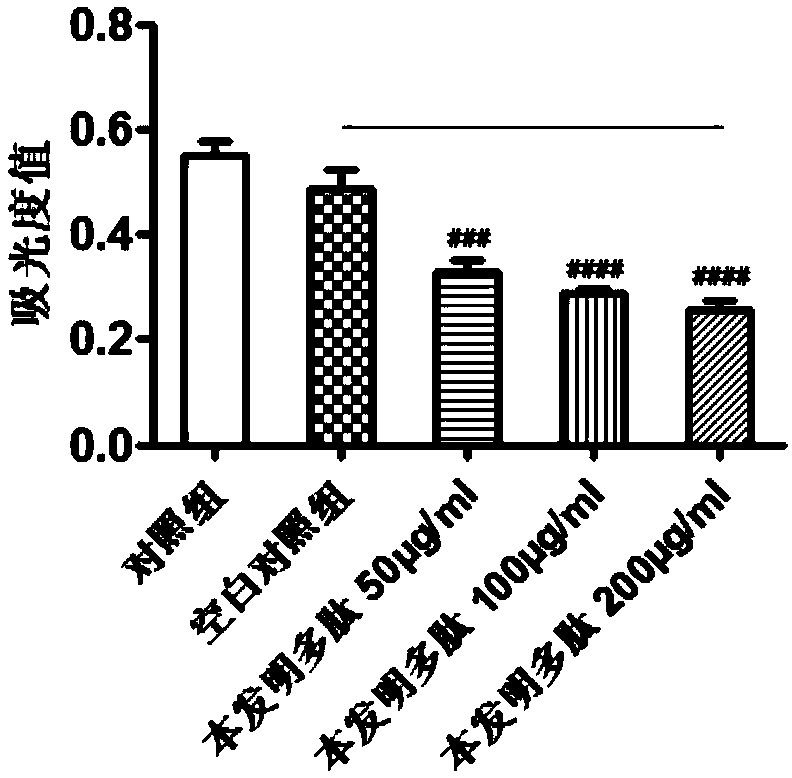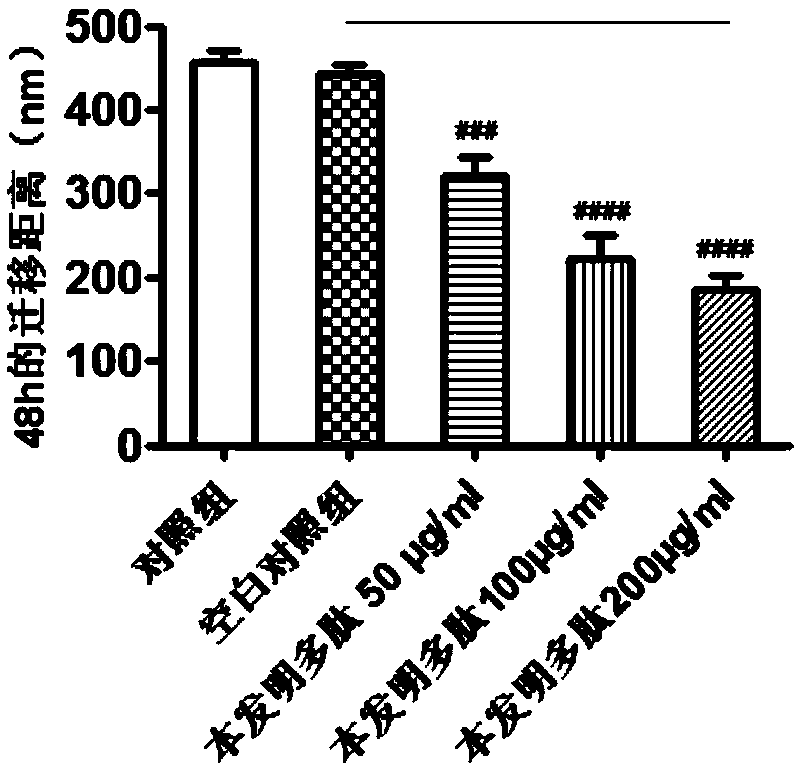Polypeptide used for inhibiting oral squamous cell carcinoma migration and invasion capacities and application thereof
A squamous cell carcinoma and oral cavity technology, applied in the field of biomedicine, can solve the problems of poor prognosis and oral function damage in patients with oral squamous cell carcinoma, and achieve the effect of inhibiting the ability of migration and invasion.
- Summary
- Abstract
- Description
- Claims
- Application Information
AI Technical Summary
Problems solved by technology
Method used
Image
Examples
Embodiment 1
[0026] Embodiment 1: cell proliferation experiment
[0027] 1. Digest CAL-27 cells in the logarithmic phase with trypsin, collect by centrifugation after the digestion is terminated, and make a cell suspension, and adjust the concentration to 1×10 4 / 200μl in a 96-well plate, and incubate at 37°C, 5% CO 2 Incubate overnight in the incubator.
[0028] 2. After 24 hours, discard the original culture medium, add culture solution containing 10% FBS and 1% double antibody to each well, add 5% glucose solution to the control group, add different concentrations of the polypeptide of the present invention to the administration group, set 6 replicate wells, at 37°C, 5% CO 2 Cultured in the incubator for 48h.
[0029] 3. After 48 hours, discard the original medium, add MTT solution (5 mg / ml) to each well, and set the zero-adjustment well, at 37 ° C, 5% CO 2 Incubate in the incubator for 4 h in the dark.
[0030] 4. After 4 hours, the original medium was discarded, and 200 μl DMSO w...
Embodiment 2
[0034] Embodiment 2: Scratch test
[0035] 1. After digesting the logarithmic phase CAL-27 cells with trypsin, count the cells to adjust the cell concentration, about 5×10 per well 5 cells.
[0036] 2. When the monolayer cell density is 100%, use a ruler and a pipette tip to perform a scratch test.
[0037] 3. Wash the cells 3 times with PBS, wash off the exfoliated cells, add cell culture medium, and give different doses of polypeptide drug solutions respectively.
[0038] 4. Put in 37℃, 5% CO 2 Incubator cultivation. Take samples at 0h and 48h, and take pictures under a microscope at 40 times.
[0039] 5. Results
[0040] The results of the scratch test showed that, compared with the blank control group, the administration group could significantly inhibit the migration of CAL-27 cell line in a dose-dependent manner, n=3, ### P#### P Figure 2a , Figure 2b ).
Embodiment 3
[0041] Embodiment 3: Transwell invasion experiment
[0042] 1. Culture cells in a 6-well plate to a cell density of 70-80%.
[0043] 2. Discard the medium, wash the cells twice with PBS, 1ml each time, and prepare medium containing different concentrations of drugs, and continue to incubate the cells for 48h.
[0044] 3. Transfer the cells to the Transwell chamber: Wash the cells in the 6-well plate twice with PBS, 1ml each time, then digest the cells with trypsin, stop the digestion with 1ml medium containing 10% FBS, and transfer the digested cells to In a 15ml centrifuge tube, centrifuge at 1000rpm for 5min, discard the supernatant, resuspend the cells in high-sugar DMEM medium, and count the cells, adjusting the number of cells to 2×10 5 / l.
[0045] 4. Add 750 μl of DMEM medium containing 10% FBS at 37°C to the 24-well plate.
[0046] 5. Discard the liquid in the upper chamber, move the small chamber to a well containing 750 μl DMEM medium, add 400 μl high-sugar DMEM c...
PUM
 Login to View More
Login to View More Abstract
Description
Claims
Application Information
 Login to View More
Login to View More - R&D Engineer
- R&D Manager
- IP Professional
- Industry Leading Data Capabilities
- Powerful AI technology
- Patent DNA Extraction
Browse by: Latest US Patents, China's latest patents, Technical Efficacy Thesaurus, Application Domain, Technology Topic, Popular Technical Reports.
© 2024 PatSnap. All rights reserved.Legal|Privacy policy|Modern Slavery Act Transparency Statement|Sitemap|About US| Contact US: help@patsnap.com










